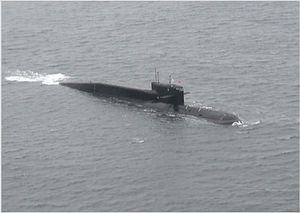Russian boomers of the Northern and Pacific Fleets test fired submarine-launched ballistic missiles (SLBM) during the annual Russian nuclear forces readiness exercise, dubbed “Grom [Thunder] 2019,” according to the Russian Ministry of Defense (MoD).
“The strategic missile-carrying submarines of the Northern and Pacific Fleets test-launched ballistic missiles from the Barents and Okhotsk Seas towards the Kura practice range in Kamchatka and the Chizha training ground in the Arkhangelsk Region,” the MoD said in a statement.
All the SLBMs reportedly struck their designated targets. (There have been reports that one SLBM failed to leave its silo.) The MoD did not specific the number or types of missiles launched, or the specific class of submarines involved. According to earlier reports, the exercise involved the firing of RSM-50 (NATO reporting name: SS-N-18 Stingray) and R-29RMU Sineva (NATO reporting name: SS-N-23A Skiff) SLBMs.
These types of SLBMs can be fired from Soviet-era Project 667BDR Kal’mar (Squid) Delta-III or Project 667 BDRM Delta IV nuclear-powered ballistic missile submarines (SSBNs).
As I noted previously, the exercise did not include the participation of the Russian Navy’s newest boomer armed with its most advanced SLBM, the Project 955 Borei-class (“North Wind”) aka Dolgoruky-class carrying the Bulava RSM-56 (NATO reporting name: SS-N-30) ICBM — a sea-based variant of the Topol-M — capable of carrying up to ten warheads.
Additionally, “the surface ships of the Northern Fleet and the Caspian Flotilla launched Kalibr precision cruise missiles from the Barents and Caspian Seas against coastal targets,” the MoD statement reads.
The Russian Navy currently operates both the 3M14K (NATO reporting name: SS-N-30A) and 3M14T, both inertial guidance land attacks variants, of the stand-off supersonic anti-ship cruise missile with an estimated operational range of 1,500 to 2,500 kilometers.
According to the to the head of the Russian Ministry of Defense’s (MoD) Main Department for International Military Cooperation, Major General Yevgeny Ilyin, the exercise involved the test firing of 16 cruise and ballistic missiles.
This included the test firing of a Topol MR/RS-24 Yars (NATO reporting name: SS-29) road-mobile intercontinental ballistic missile (ICBM). “The team of the Yars mobile missile system launched an intercontinental ballistic missile from the Plesetsk State Testing Cosmodrome against the Kura range in Kamchatka,” the MoD statement says.
The Yars is a three-stage solid fueled ICBM, capable of carrying three to six multiple independently targetable reentry vehicles (MIRVs), as well as a number of active and passive decoys.
Thunder 2019 took place from October 15 to 17 in all five military districts across Russia including the Western, Southern, Central and Eastern districts. It involved 12,000 troops, 213 intercontinental-range ballistic missile launchers, up to 105 aircraft and around 20 warships, according to the MoD.

































